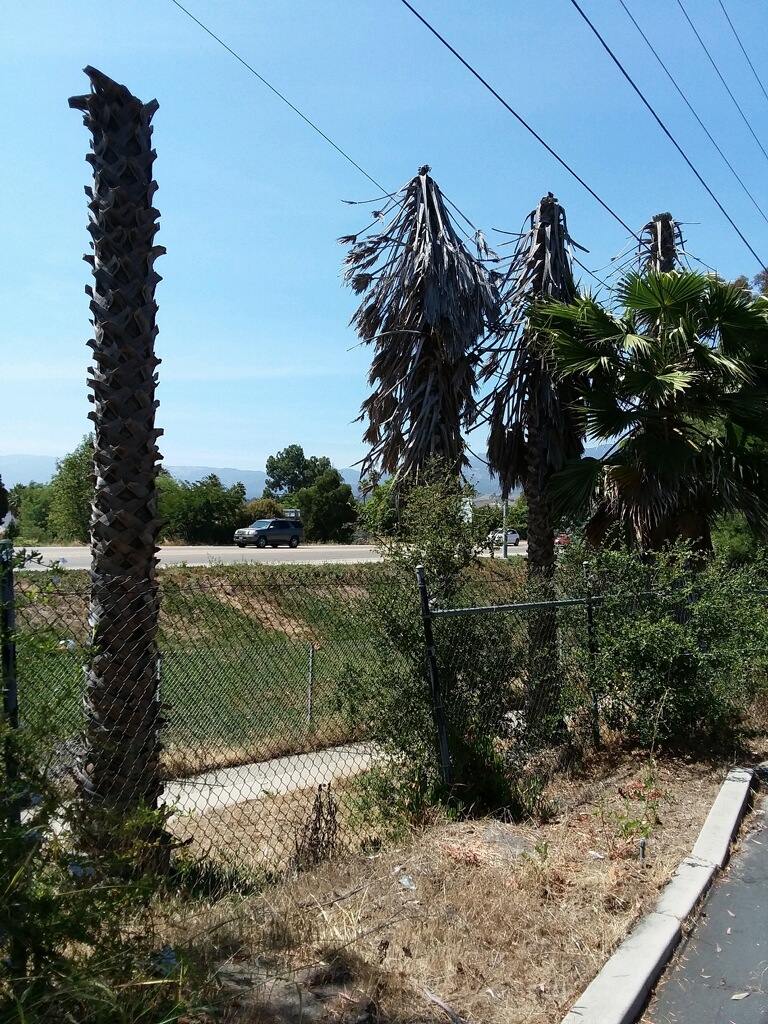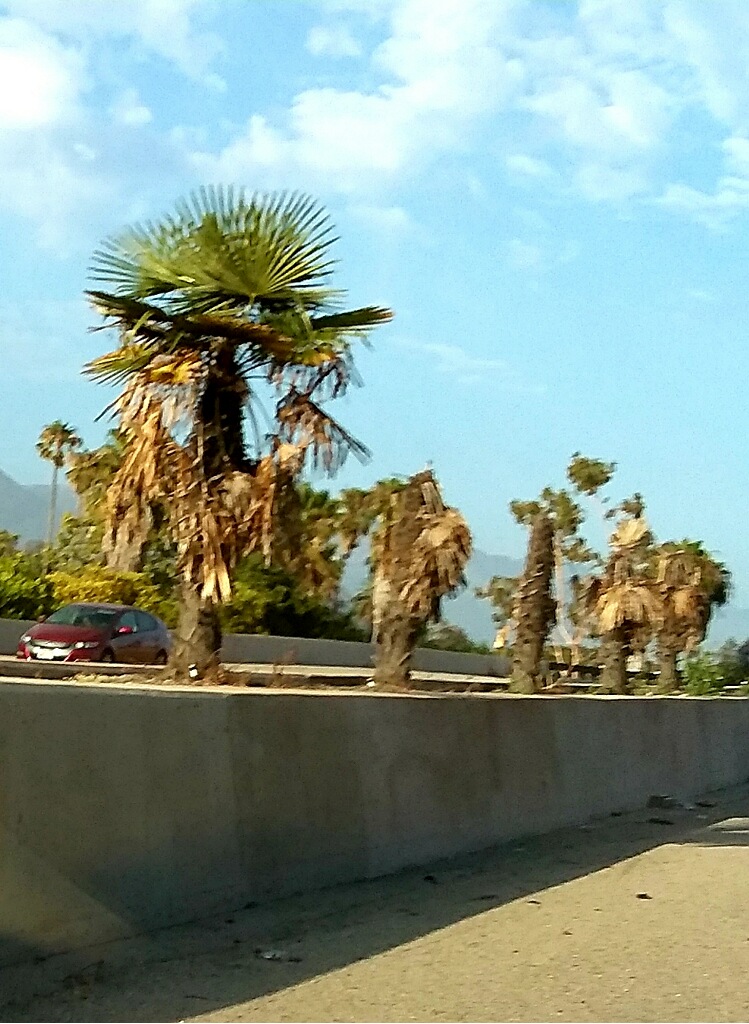Palm-Lined Path to Paradise?
Q. Palm trees are being suggested as part of the recently rolled-out design schemes for the new 101 and Coast Village Road projects. I see from national news reports that palms throughout Southern California are dying from disease and being removed. Why are we installing palms if everyone else is getting rid of them?

A. Is your question punctuated by a daily drive along the city’s 101 median, where about a dozen failing palms poke up their dead, black heads? That strand makes quite an exclamation point about the suitability of palms for road landscaping purposes!
Your question, if it’s thumbs-up or thumbs-down to palms embellishing our expensive, long-awaited roadway projects, is well-timed. Palms are featured in both the 101 Sheffield landscape design and the Coast Village Road Roundabout plan, recently rolled out by the Santa Barbara County Association of Governments (SBCAG).
Those designs are now making the rounds to gather public input. Among the stops were several MBAR meetings where conceptual comments were offered. Initially the board favored a more “cultural” traditional landscape of Cypress and Juniper, reminiscent of the historical Montecito Parkway. However at the last meeting, an MBAR-frond waving board member rallied for palm tree inclusion – noting they “say California.” So, hey dude, what could the board do – they demurred, peacefully adding palms to the pallet.
That decision may have been understudied and could end up being costly to the taxpayer. A story in the Tampa Bay Times notes thousands of date palm trees along highways in Florida and Texas are dying from a disease called “Lethal Bronzing.” The story explains Tampa is taking a proactive approach by inoculating 300 trees every four months with an antibiotic at a cost of $9,000.
Since 2017, Los Angeles has had to remove hundreds, if not thousands, of diseased and dying palms. Even though some 75,000 palms stand as criterion to of the image of L.A., the city has decided, except in culturally important sties, not to replace the dead palms with palms, choosing instead more sturdy replacements. After environmental considerations, arborists believe there are better choices. Palms, they note, do not provide much shade, they are more of a grass than a tree so they don’t fight pollution, and they are a favorite nesting place of Norwegian Tree Rats.

Most concerning, however, is that palms can be jeopardized by a variety of diseases. Other than the California Fan Palm (Washingtonia filigera), palms are not native to California and while a fungus is normally harmless to native plants, it can be deadly to non-native palms. Some of these attacking-diseases are fatal, some are not and some can be treated at a high cost.
Evergreen Arborist Consultants notes Queen, Mexican Fan, California Fan, and Kentia Palms can be threatened by a fungus called Pink Rot. It can be controlled by pruning and proper irrigation. Diamond Scale, a fungus, rarely causes death but it can compromise the aesthetics of a palm by causing browning of the leaves.
The University of Californian Cooperative Extension Ventura reports the expensive ($10,000 plus) Canary Island Date Palm can be infected by Fusarium Wilt, which weakens the plant, usually leading to its death. The Cooperative’s informational directive adds that disease is often carried mechanically by pruning equipment and the life of palms can be hindered by planting, soil, watering, pruning, or “planting out,” which is isolating individual trees from a more wind protected grove of palms.
Finally, as to those picture-perfect postcards of palm-covered native California – well it’s only in the movies! It seems palms were brought into Southern California in the 1920s to sell the bleak desert land.
Nataly Keomoungkhou, in USC Storyspace, reveals palms were just a prop. Quoting Victoria Dailey from Piety and Perversion: The Palms of Los Angeles, “Palms were useful in selling Hollywood as a new Mecca, just as they had sold Los Angeles as a desert Eden. Los Angeles was primed to become one big movie set, a fantasy land, a city of palms signifying ‘anything goes’ – and it did.”
Now that the glamour is erased, what do our local experts have to say about the practicality of palm-lined projects? MBAR vice-chair and respected local landscape architect Sam Maphis, who has formally reviewed both the 101 and the Coast Village Road projects, says he is open to palms, but continues to investigate any durability issues.
“There are a large variety of palms that grow on our south coast and there are many we could recommend for these projects that would not be affected by the potential of diseases. Some smaller, lower palms are more resilient to these biological challenges,” Maphis explained. “The most resilient trees should be chosen for these projects for long-term durable landscape.”
And, Jim Shivers, public information officer for Caltrans District Five, says palm disease or demise has not been cause for Caltrans concern. “The only palms affected that are in our right of way in Santa Barbara is the Canary Island Palm. That said we have several other palms species in the right of way and median including Mexican Fan Palms, Windmill Palms, and Queen Palms that are not being impacted,” he explained.
“While the Canary Island Date Palm has had a large amount of die-off in the Southern California region, it does not appear that the Mexican Fan Palm has been experiencing this blight. The Mexican Fan Palm has had some blight issues in Florida, but so far, not here as far as we can tell.”
Shivers added the designer responsible for the Sheffield portion of the landscape design said palms may be included in the planting palette but, at MBAR’s suggestion, they will not be a major feature of the landscape and not arranged in a dominant or formal manner. Shivers said the designer explained the current proposed plan has some random scattering or groupings of Mexican Fan Palm interspersed with evergreen species like Monterey Cypress and Coast Live Oak which are the more dominant species of the planting concept.
Congratulations! You are now a Master of Palms, so go forward with your new knowledge and opinions! The next opportunity will be on September 3 at 4 pm at the Montecito Association Land Use Committee. Acting-Land Use Chair, Dorinne Lee Johnson, says the Olive Mill Roundabout, with its proposed palm-lined corridor, will be on the agenda. The fate of Montecito roadway palm trees – magical or maiming – now rests in the palms of the public’s hands!







You must be logged in to post a comment.